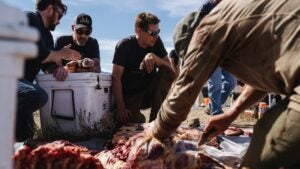The American Buffalo Documentary by Ken Burns Looks at the Slaughter—and Salvation—of Bison
In the new PBS documentary 'The American Buffalo' by Ken Burns, the filmmaker goes deep on the near-extermination of bison, unearthing stories that shaped—and still haunt—this country's soul
New perk: Easily find new routes and hidden gems, upcoming running events, and more near you. Your weekly Local Running Newsletter has everything you need to lace up! .
At times it seems like the earth is so upset about what happened to the American buffalo that it literally vomits up the remains. It’s amazing how bones continue to pop out of the ground. I found my first skull in 1999, poking up from the soil at 9,000 feet above sea level in the mountains of southwest Montana. Radiocarbon dating placed the year of the animal’s death at around 1770, a time when there were still perhaps 30 million of the animals on the American landscape.
Back then the famed hunter Daniel Boone was still encountering buffalo, now known to scientists as Bison bison, as far east as Kentucky and North Carolina. Native Americans living in the vicinity of where I found my skull were largely unaware of the Europeans advancing toward them from that direction. Most had probably heard of white men but had yet to see one. Certainly they couldn’t have imagined that these strange people would exterminate the herds they’d relied on for hundreds of generations in just over a century.
I keep finding more and more bones. I found buffalo vertebrae eroding from the banks of the Yellowstone River, with the absurdly long spinous process that gives the animal the distinctive hump on its back. Then I found two skulls in a Yellowstone tributary—on different days, but not more than a mile apart. One was just the upper-right quadrant of a skull, tipping out of the river’s west bank. The other was nearly complete, lying flush with the river cobbles in ankle-deep water. When I lifted it up, I was surprised to find a half-dozen juvenile crayfish occupying its sinus cavities.
A month later I would find myself in Fort Benton, Montana, north of the drainage divide that separates the Yellowstone and Upper Missouri Rivers. I was there to be interviewed for the latest project by the documentarian Ken Burns, titled premiering on PBS on October 16. Through a career spanning more than four decades and around 40 films, Burns has been doing his own form of bone digging, unearthing the stories that shaped America’s identity and, at times, haunted its soul. In searching for lessons about America’s relationship to its wildlife, the complex and centuries-long story of the bison’s near extinction is indeed fertile ground for Burns to excavate.
Burns told me that he and his team considered the subject of the American buffalo for 30 years before making the film. He recalls giving the film’s writer, Dayton Duncan, the gift of a tanned buffalo hide back in the 1990s. (Duncan’s writing credits include the Burns docs Country Music, The Dust Bowl, The National Parks, and Lewis and Clark.) “Some films take a long time to incubate,” Burns told me. He said that he keeps dozens of ideas in his head at all times. He resisted my question about how he prioritizes them, because he said that “prioritize” implied an organized mind. Rather, he compared his ideas to the numbered Ping-Pong balls in a lottery machine. They bounce around in your head, he said, “and then one drops down to your heart.”
It says a lot about the richness of the subject that you can make a two-part, four-hour documentary on the American buffalo without saying much about the animals themselves. The evolutionary history of the species, which spans millions of years and multiple continents, gets less than a minute of consideration in Burns’s film. There’s no mention of the animal’s incredible cold tolerance, which blows away that of a Tibetan yak. (In the 1970s, the director of the Alberta Veterinary Researchers Institute tried to find the point where a buffalo’s metabolic rate increased in response to the cold. It was still decreasing at minus 22 degrees Fahrenheit, as cold as they could get the room.)
Or of the species’ propensity to suffer staggering numbers of deaths even in the absence of any humans: two thousand of the animals expired in the mud of the Platte River in 1867; a quarter-mile-long pile was stacked by a tornado near the Arkansas River; so many were killed by a Wyoming prairie fire in 1864 that Sioux warriors had a hard time getting their horses through the carnage; and approximately ten thousand drowned in Canada’s Saskatchewan River in 1829.
Instead, the documentary is a human tale hiding inside a film about animals. “It’s the story of us,” said Burns. “Both uppercase, as in the U.S., and lowercase, as in us humans.”









